Managerial Economics Case Study on AirAsia Malaysia
VerifiedAdded on 2022/11/16
|18
|4465
|457
AI Summary
The paper is a case study about the company AirAsia Malaysia. It brings about the growth objectives of the firm and recommends the area where it needs to improve by using the principles of Managerial Economics.
Contribute Materials
Your contribution can guide someone’s learning journey. Share your
documents today.
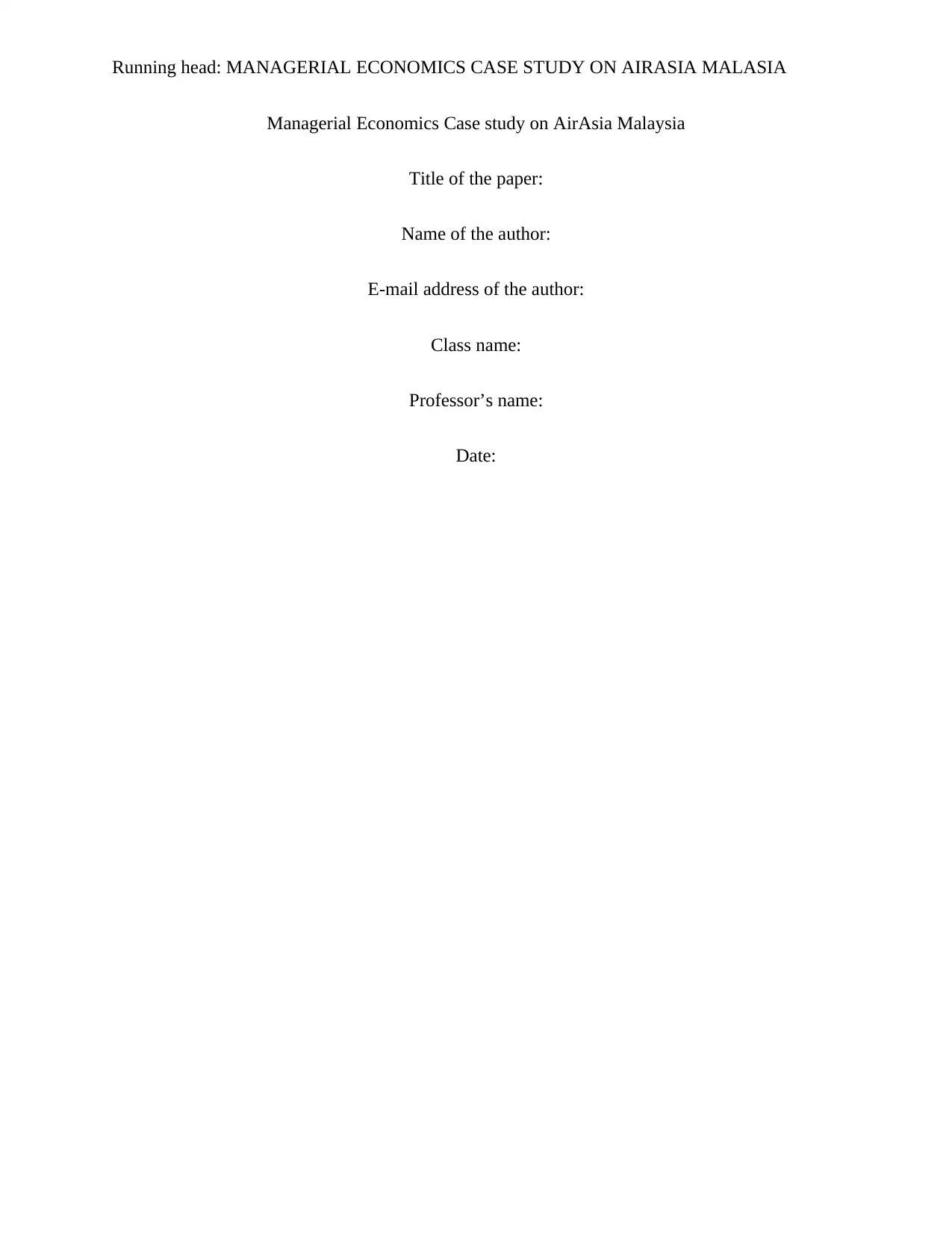
Running head: MANAGERIAL ECONOMICS CASE STUDY ON AIRASIA MALASIA
Managerial Economics Case study on AirAsia Malaysia
Title of the paper:
Name of the author:
E-mail address of the author:
Class name:
Professor’s name:
Date:
Managerial Economics Case study on AirAsia Malaysia
Title of the paper:
Name of the author:
E-mail address of the author:
Class name:
Professor’s name:
Date:
Secure Best Marks with AI Grader
Need help grading? Try our AI Grader for instant feedback on your assignments.
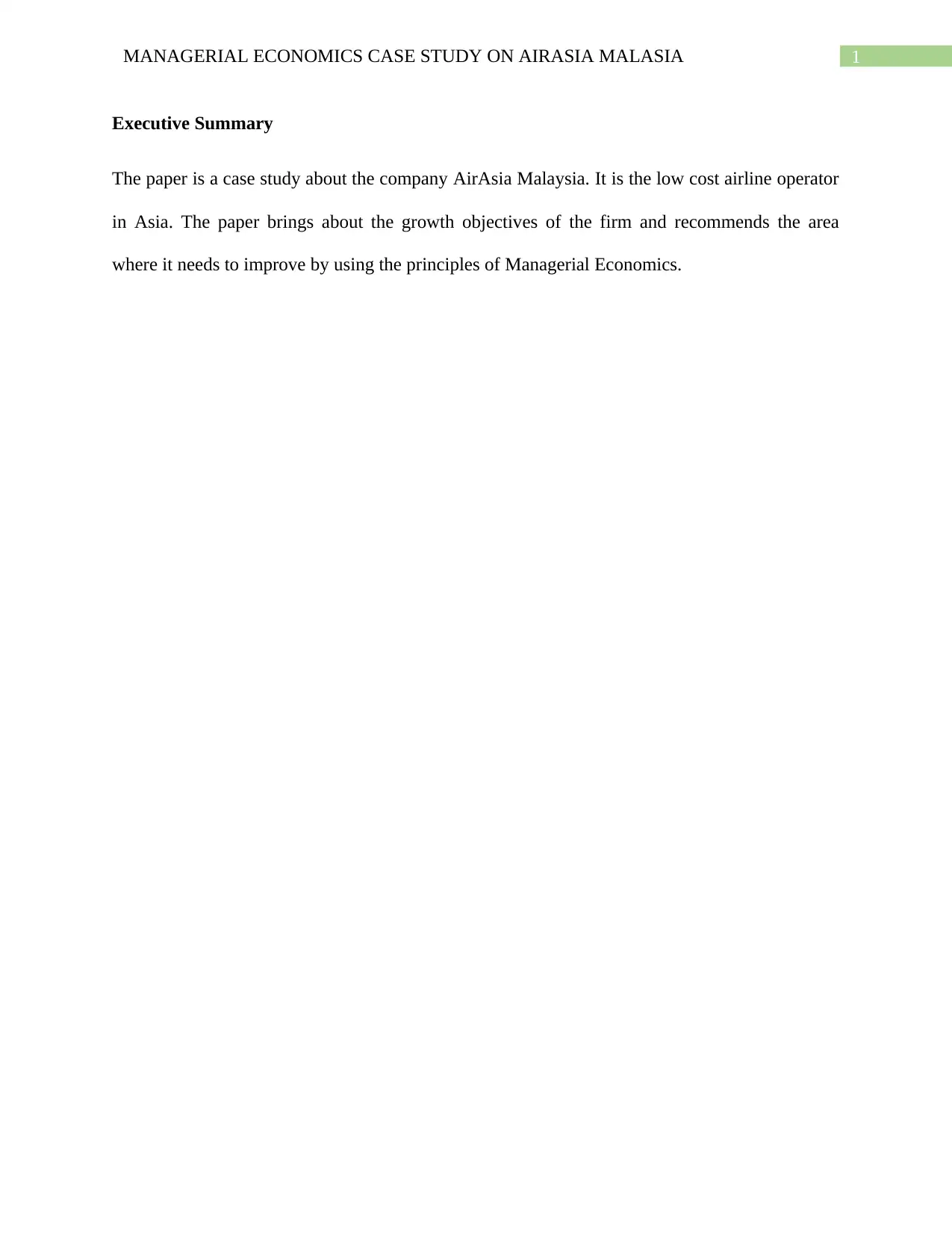
1MANAGERIAL ECONOMICS CASE STUDY ON AIRASIA MALASIA
Executive Summary
The paper is a case study about the company AirAsia Malaysia. It is the low cost airline operator
in Asia. The paper brings about the growth objectives of the firm and recommends the area
where it needs to improve by using the principles of Managerial Economics.
Executive Summary
The paper is a case study about the company AirAsia Malaysia. It is the low cost airline operator
in Asia. The paper brings about the growth objectives of the firm and recommends the area
where it needs to improve by using the principles of Managerial Economics.
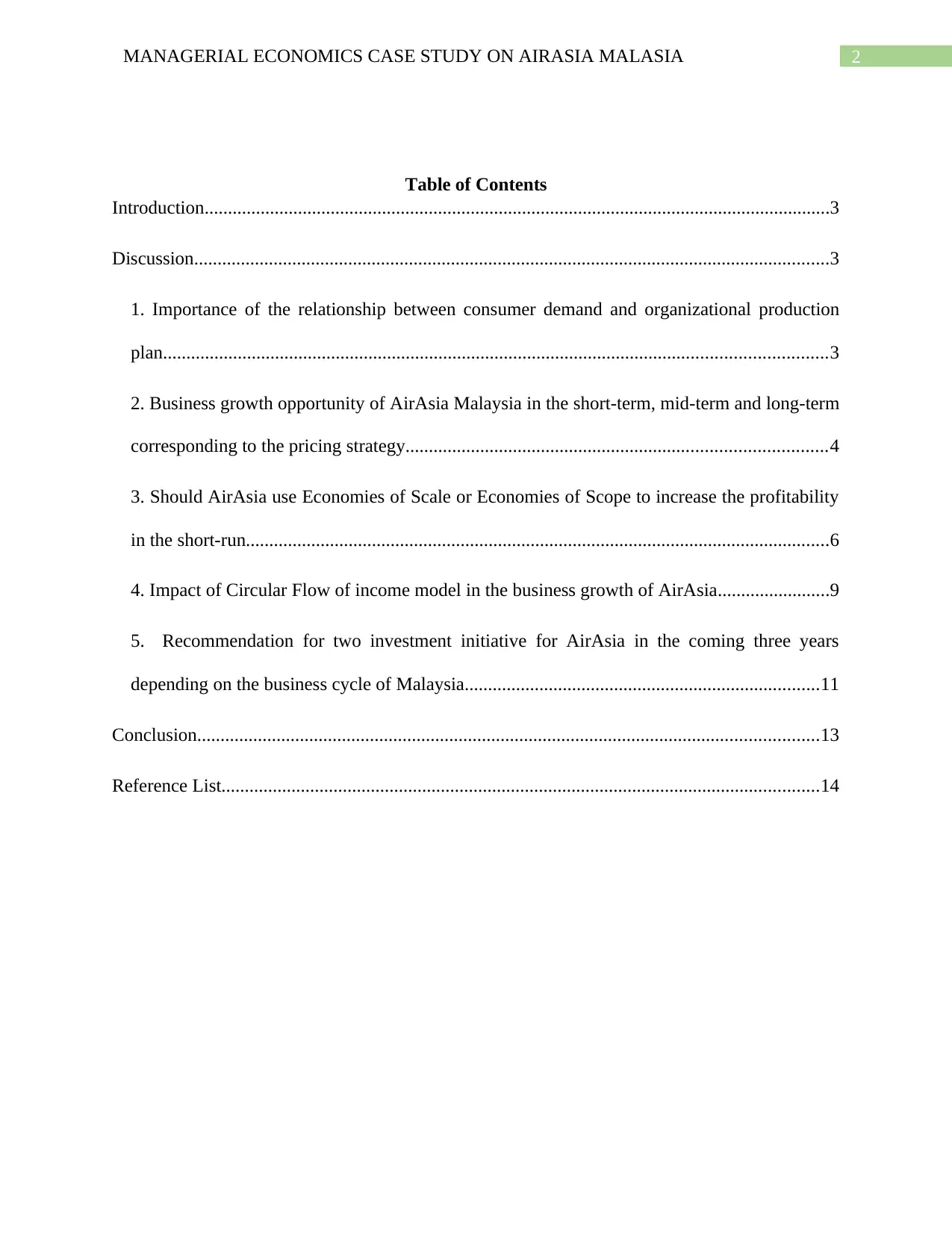
2MANAGERIAL ECONOMICS CASE STUDY ON AIRASIA MALASIA
Table of Contents
Introduction......................................................................................................................................3
Discussion........................................................................................................................................3
1. Importance of the relationship between consumer demand and organizational production
plan..............................................................................................................................................3
2. Business growth opportunity of AirAsia Malaysia in the short-term, mid-term and long-term
corresponding to the pricing strategy..........................................................................................4
3. Should AirAsia use Economies of Scale or Economies of Scope to increase the profitability
in the short-run.............................................................................................................................6
4. Impact of Circular Flow of income model in the business growth of AirAsia........................9
5. Recommendation for two investment initiative for AirAsia in the coming three years
depending on the business cycle of Malaysia............................................................................11
Conclusion.....................................................................................................................................13
Reference List................................................................................................................................14
Table of Contents
Introduction......................................................................................................................................3
Discussion........................................................................................................................................3
1. Importance of the relationship between consumer demand and organizational production
plan..............................................................................................................................................3
2. Business growth opportunity of AirAsia Malaysia in the short-term, mid-term and long-term
corresponding to the pricing strategy..........................................................................................4
3. Should AirAsia use Economies of Scale or Economies of Scope to increase the profitability
in the short-run.............................................................................................................................6
4. Impact of Circular Flow of income model in the business growth of AirAsia........................9
5. Recommendation for two investment initiative for AirAsia in the coming three years
depending on the business cycle of Malaysia............................................................................11
Conclusion.....................................................................................................................................13
Reference List................................................................................................................................14
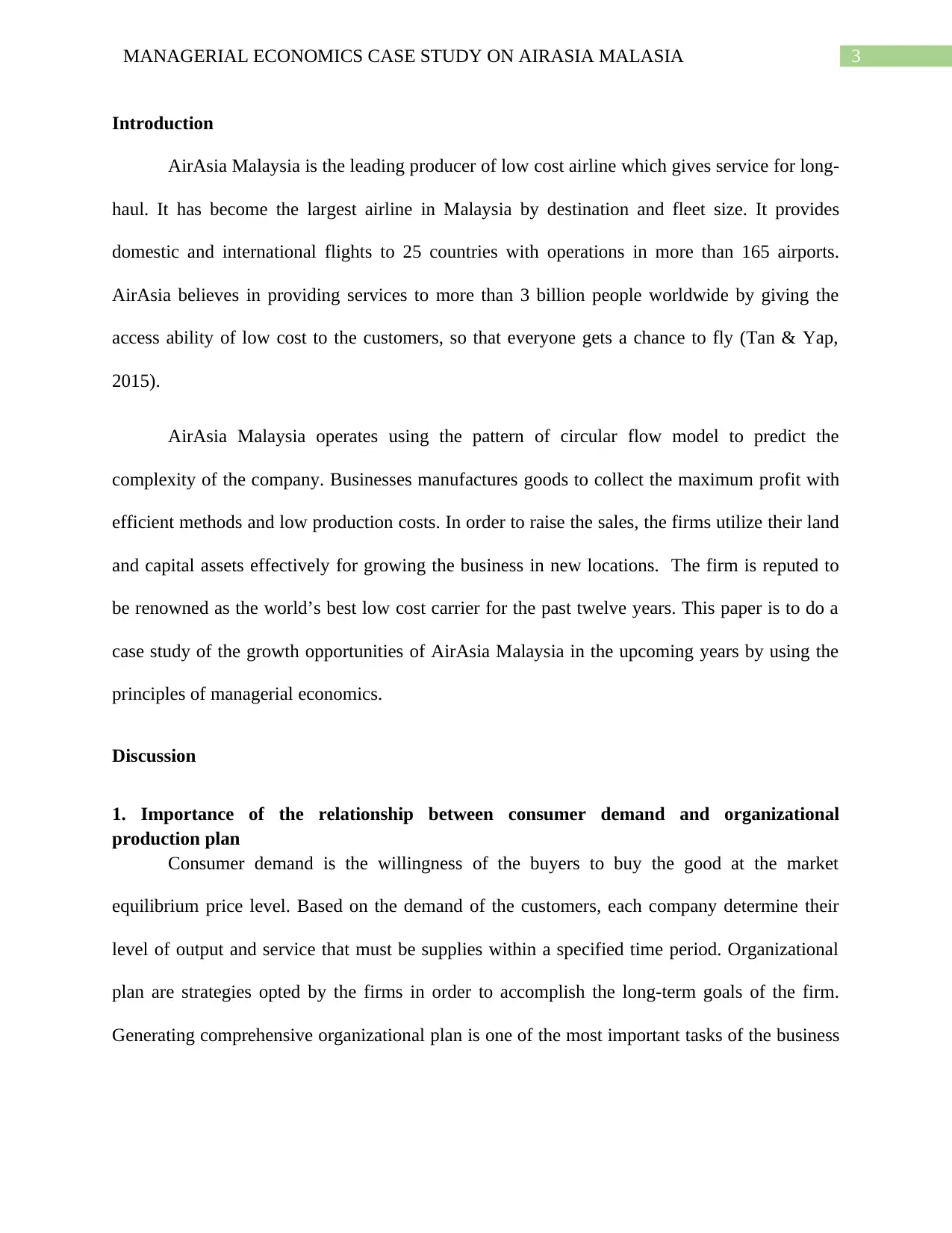
3MANAGERIAL ECONOMICS CASE STUDY ON AIRASIA MALASIA
Introduction
AirAsia Malaysia is the leading producer of low cost airline which gives service for long-
haul. It has become the largest airline in Malaysia by destination and fleet size. It provides
domestic and international flights to 25 countries with operations in more than 165 airports.
AirAsia believes in providing services to more than 3 billion people worldwide by giving the
access ability of low cost to the customers, so that everyone gets a chance to fly (Tan & Yap,
2015).
AirAsia Malaysia operates using the pattern of circular flow model to predict the
complexity of the company. Businesses manufactures goods to collect the maximum profit with
efficient methods and low production costs. In order to raise the sales, the firms utilize their land
and capital assets effectively for growing the business in new locations. The firm is reputed to
be renowned as the world’s best low cost carrier for the past twelve years. This paper is to do a
case study of the growth opportunities of AirAsia Malaysia in the upcoming years by using the
principles of managerial economics.
Discussion
1. Importance of the relationship between consumer demand and organizational
production plan
Consumer demand is the willingness of the buyers to buy the good at the market
equilibrium price level. Based on the demand of the customers, each company determine their
level of output and service that must be supplies within a specified time period. Organizational
plan are strategies opted by the firms in order to accomplish the long-term goals of the firm.
Generating comprehensive organizational plan is one of the most important tasks of the business
Introduction
AirAsia Malaysia is the leading producer of low cost airline which gives service for long-
haul. It has become the largest airline in Malaysia by destination and fleet size. It provides
domestic and international flights to 25 countries with operations in more than 165 airports.
AirAsia believes in providing services to more than 3 billion people worldwide by giving the
access ability of low cost to the customers, so that everyone gets a chance to fly (Tan & Yap,
2015).
AirAsia Malaysia operates using the pattern of circular flow model to predict the
complexity of the company. Businesses manufactures goods to collect the maximum profit with
efficient methods and low production costs. In order to raise the sales, the firms utilize their land
and capital assets effectively for growing the business in new locations. The firm is reputed to
be renowned as the world’s best low cost carrier for the past twelve years. This paper is to do a
case study of the growth opportunities of AirAsia Malaysia in the upcoming years by using the
principles of managerial economics.
Discussion
1. Importance of the relationship between consumer demand and organizational
production plan
Consumer demand is the willingness of the buyers to buy the good at the market
equilibrium price level. Based on the demand of the customers, each company determine their
level of output and service that must be supplies within a specified time period. Organizational
plan are strategies opted by the firms in order to accomplish the long-term goals of the firm.
Generating comprehensive organizational plan is one of the most important tasks of the business
Secure Best Marks with AI Grader
Need help grading? Try our AI Grader for instant feedback on your assignments.
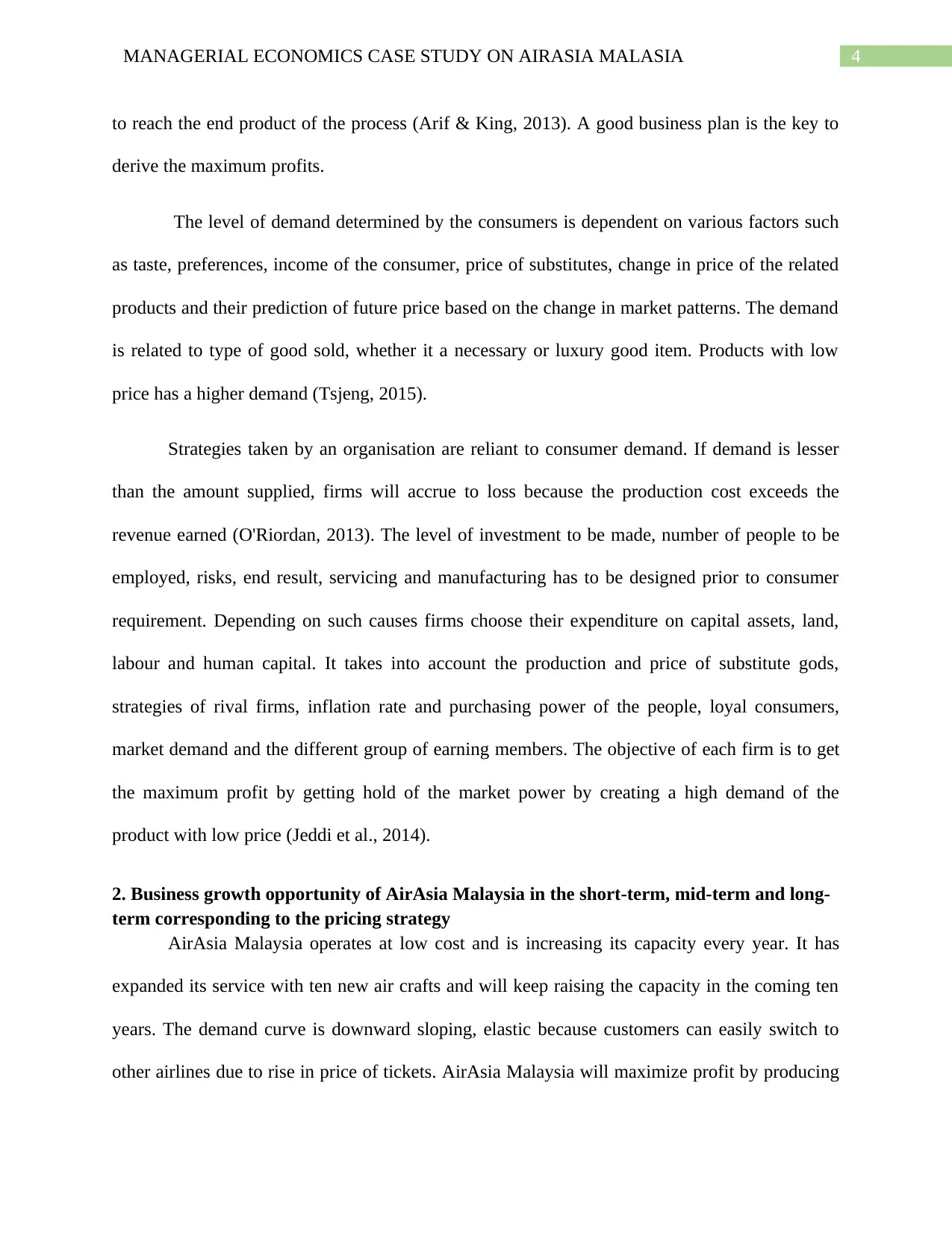
4MANAGERIAL ECONOMICS CASE STUDY ON AIRASIA MALASIA
to reach the end product of the process (Arif & King, 2013). A good business plan is the key to
derive the maximum profits.
The level of demand determined by the consumers is dependent on various factors such
as taste, preferences, income of the consumer, price of substitutes, change in price of the related
products and their prediction of future price based on the change in market patterns. The demand
is related to type of good sold, whether it a necessary or luxury good item. Products with low
price has a higher demand (Tsjeng, 2015).
Strategies taken by an organisation are reliant to consumer demand. If demand is lesser
than the amount supplied, firms will accrue to loss because the production cost exceeds the
revenue earned (O'Riordan, 2013). The level of investment to be made, number of people to be
employed, risks, end result, servicing and manufacturing has to be designed prior to consumer
requirement. Depending on such causes firms choose their expenditure on capital assets, land,
labour and human capital. It takes into account the production and price of substitute gods,
strategies of rival firms, inflation rate and purchasing power of the people, loyal consumers,
market demand and the different group of earning members. The objective of each firm is to get
the maximum profit by getting hold of the market power by creating a high demand of the
product with low price (Jeddi et al., 2014).
2. Business growth opportunity of AirAsia Malaysia in the short-term, mid-term and long-
term corresponding to the pricing strategy
AirAsia Malaysia operates at low cost and is increasing its capacity every year. It has
expanded its service with ten new air crafts and will keep raising the capacity in the coming ten
years. The demand curve is downward sloping, elastic because customers can easily switch to
other airlines due to rise in price of tickets. AirAsia Malaysia will maximize profit by producing
to reach the end product of the process (Arif & King, 2013). A good business plan is the key to
derive the maximum profits.
The level of demand determined by the consumers is dependent on various factors such
as taste, preferences, income of the consumer, price of substitutes, change in price of the related
products and their prediction of future price based on the change in market patterns. The demand
is related to type of good sold, whether it a necessary or luxury good item. Products with low
price has a higher demand (Tsjeng, 2015).
Strategies taken by an organisation are reliant to consumer demand. If demand is lesser
than the amount supplied, firms will accrue to loss because the production cost exceeds the
revenue earned (O'Riordan, 2013). The level of investment to be made, number of people to be
employed, risks, end result, servicing and manufacturing has to be designed prior to consumer
requirement. Depending on such causes firms choose their expenditure on capital assets, land,
labour and human capital. It takes into account the production and price of substitute gods,
strategies of rival firms, inflation rate and purchasing power of the people, loyal consumers,
market demand and the different group of earning members. The objective of each firm is to get
the maximum profit by getting hold of the market power by creating a high demand of the
product with low price (Jeddi et al., 2014).
2. Business growth opportunity of AirAsia Malaysia in the short-term, mid-term and long-
term corresponding to the pricing strategy
AirAsia Malaysia operates at low cost and is increasing its capacity every year. It has
expanded its service with ten new air crafts and will keep raising the capacity in the coming ten
years. The demand curve is downward sloping, elastic because customers can easily switch to
other airlines due to rise in price of tickets. AirAsia Malaysia will maximize profit by producing
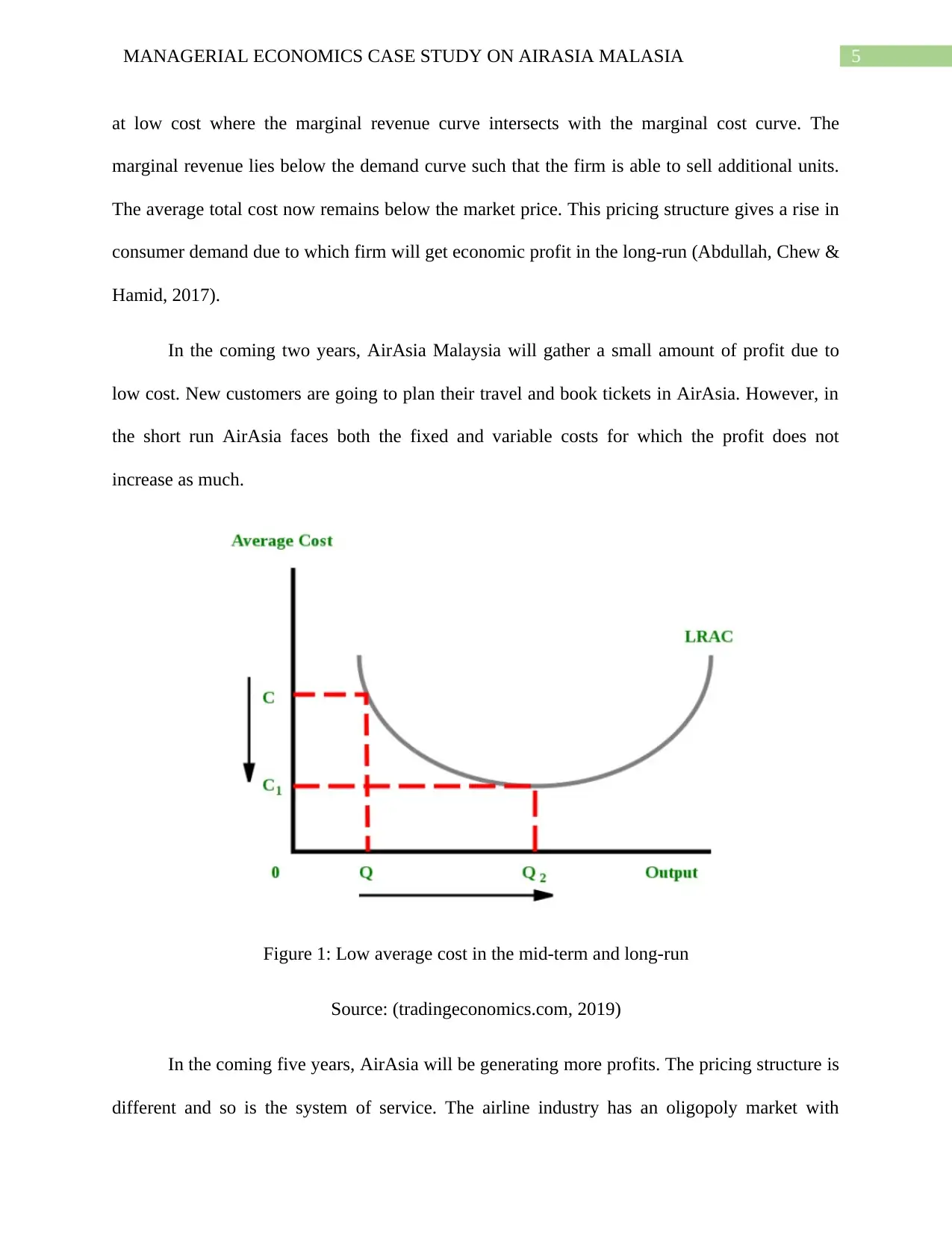
5MANAGERIAL ECONOMICS CASE STUDY ON AIRASIA MALASIA
at low cost where the marginal revenue curve intersects with the marginal cost curve. The
marginal revenue lies below the demand curve such that the firm is able to sell additional units.
The average total cost now remains below the market price. This pricing structure gives a rise in
consumer demand due to which firm will get economic profit in the long-run (Abdullah, Chew &
Hamid, 2017).
In the coming two years, AirAsia Malaysia will gather a small amount of profit due to
low cost. New customers are going to plan their travel and book tickets in AirAsia. However, in
the short run AirAsia faces both the fixed and variable costs for which the profit does not
increase as much.
Figure 1: Low average cost in the mid-term and long-run
Source: (tradingeconomics.com, 2019)
In the coming five years, AirAsia will be generating more profits. The pricing structure is
different and so is the system of service. The airline industry has an oligopoly market with
at low cost where the marginal revenue curve intersects with the marginal cost curve. The
marginal revenue lies below the demand curve such that the firm is able to sell additional units.
The average total cost now remains below the market price. This pricing structure gives a rise in
consumer demand due to which firm will get economic profit in the long-run (Abdullah, Chew &
Hamid, 2017).
In the coming two years, AirAsia Malaysia will gather a small amount of profit due to
low cost. New customers are going to plan their travel and book tickets in AirAsia. However, in
the short run AirAsia faces both the fixed and variable costs for which the profit does not
increase as much.
Figure 1: Low average cost in the mid-term and long-run
Source: (tradingeconomics.com, 2019)
In the coming five years, AirAsia will be generating more profits. The pricing structure is
different and so is the system of service. The airline industry has an oligopoly market with
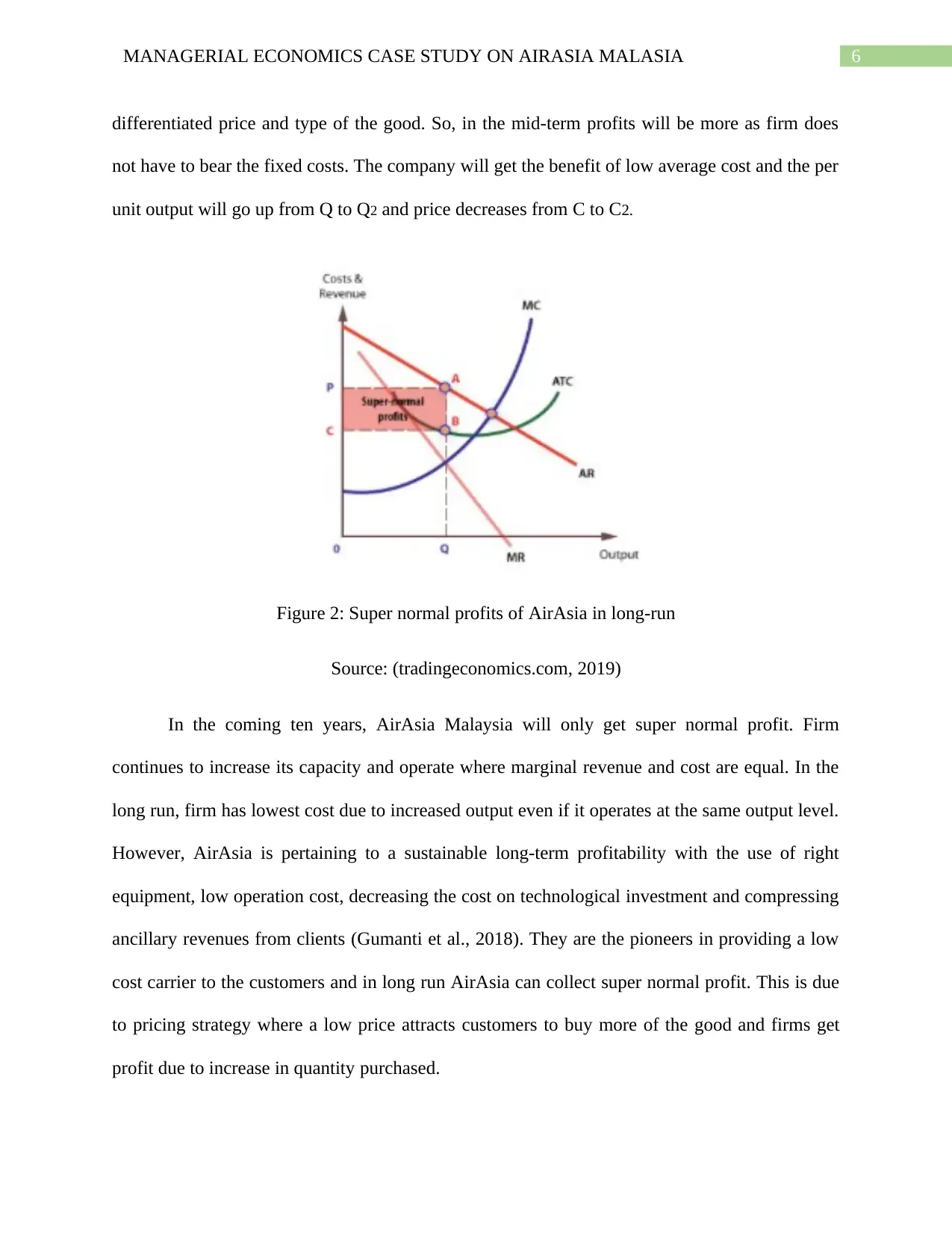
6MANAGERIAL ECONOMICS CASE STUDY ON AIRASIA MALASIA
differentiated price and type of the good. So, in the mid-term profits will be more as firm does
not have to bear the fixed costs. The company will get the benefit of low average cost and the per
unit output will go up from Q to Q2 and price decreases from C to C2.
Figure 2: Super normal profits of AirAsia in long-run
Source: (tradingeconomics.com, 2019)
In the coming ten years, AirAsia Malaysia will only get super normal profit. Firm
continues to increase its capacity and operate where marginal revenue and cost are equal. In the
long run, firm has lowest cost due to increased output even if it operates at the same output level.
However, AirAsia is pertaining to a sustainable long-term profitability with the use of right
equipment, low operation cost, decreasing the cost on technological investment and compressing
ancillary revenues from clients (Gumanti et al., 2018). They are the pioneers in providing a low
cost carrier to the customers and in long run AirAsia can collect super normal profit. This is due
to pricing strategy where a low price attracts customers to buy more of the good and firms get
profit due to increase in quantity purchased.
differentiated price and type of the good. So, in the mid-term profits will be more as firm does
not have to bear the fixed costs. The company will get the benefit of low average cost and the per
unit output will go up from Q to Q2 and price decreases from C to C2.
Figure 2: Super normal profits of AirAsia in long-run
Source: (tradingeconomics.com, 2019)
In the coming ten years, AirAsia Malaysia will only get super normal profit. Firm
continues to increase its capacity and operate where marginal revenue and cost are equal. In the
long run, firm has lowest cost due to increased output even if it operates at the same output level.
However, AirAsia is pertaining to a sustainable long-term profitability with the use of right
equipment, low operation cost, decreasing the cost on technological investment and compressing
ancillary revenues from clients (Gumanti et al., 2018). They are the pioneers in providing a low
cost carrier to the customers and in long run AirAsia can collect super normal profit. This is due
to pricing strategy where a low price attracts customers to buy more of the good and firms get
profit due to increase in quantity purchased.
Paraphrase This Document
Need a fresh take? Get an instant paraphrase of this document with our AI Paraphraser
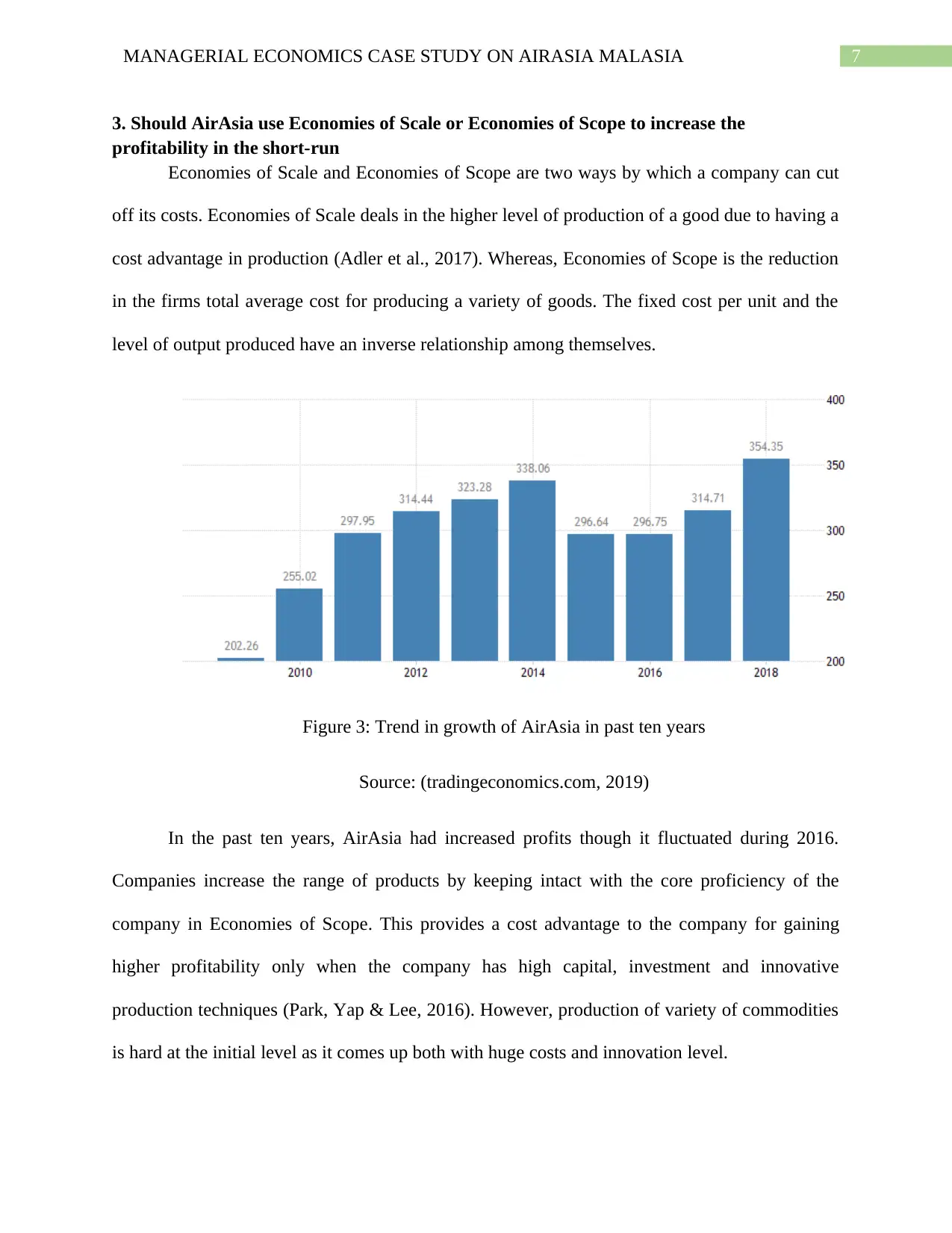
7MANAGERIAL ECONOMICS CASE STUDY ON AIRASIA MALASIA
3. Should AirAsia use Economies of Scale or Economies of Scope to increase the
profitability in the short-run
Economies of Scale and Economies of Scope are two ways by which a company can cut
off its costs. Economies of Scale deals in the higher level of production of a good due to having a
cost advantage in production (Adler et al., 2017). Whereas, Economies of Scope is the reduction
in the firms total average cost for producing a variety of goods. The fixed cost per unit and the
level of output produced have an inverse relationship among themselves.
Figure 3: Trend in growth of AirAsia in past ten years
Source: (tradingeconomics.com, 2019)
In the past ten years, AirAsia had increased profits though it fluctuated during 2016.
Companies increase the range of products by keeping intact with the core proficiency of the
company in Economies of Scope. This provides a cost advantage to the company for gaining
higher profitability only when the company has high capital, investment and innovative
production techniques (Park, Yap & Lee, 2016). However, production of variety of commodities
is hard at the initial level as it comes up both with huge costs and innovation level.
3. Should AirAsia use Economies of Scale or Economies of Scope to increase the
profitability in the short-run
Economies of Scale and Economies of Scope are two ways by which a company can cut
off its costs. Economies of Scale deals in the higher level of production of a good due to having a
cost advantage in production (Adler et al., 2017). Whereas, Economies of Scope is the reduction
in the firms total average cost for producing a variety of goods. The fixed cost per unit and the
level of output produced have an inverse relationship among themselves.
Figure 3: Trend in growth of AirAsia in past ten years
Source: (tradingeconomics.com, 2019)
In the past ten years, AirAsia had increased profits though it fluctuated during 2016.
Companies increase the range of products by keeping intact with the core proficiency of the
company in Economies of Scope. This provides a cost advantage to the company for gaining
higher profitability only when the company has high capital, investment and innovative
production techniques (Park, Yap & Lee, 2016). However, production of variety of commodities
is hard at the initial level as it comes up both with huge costs and innovation level.
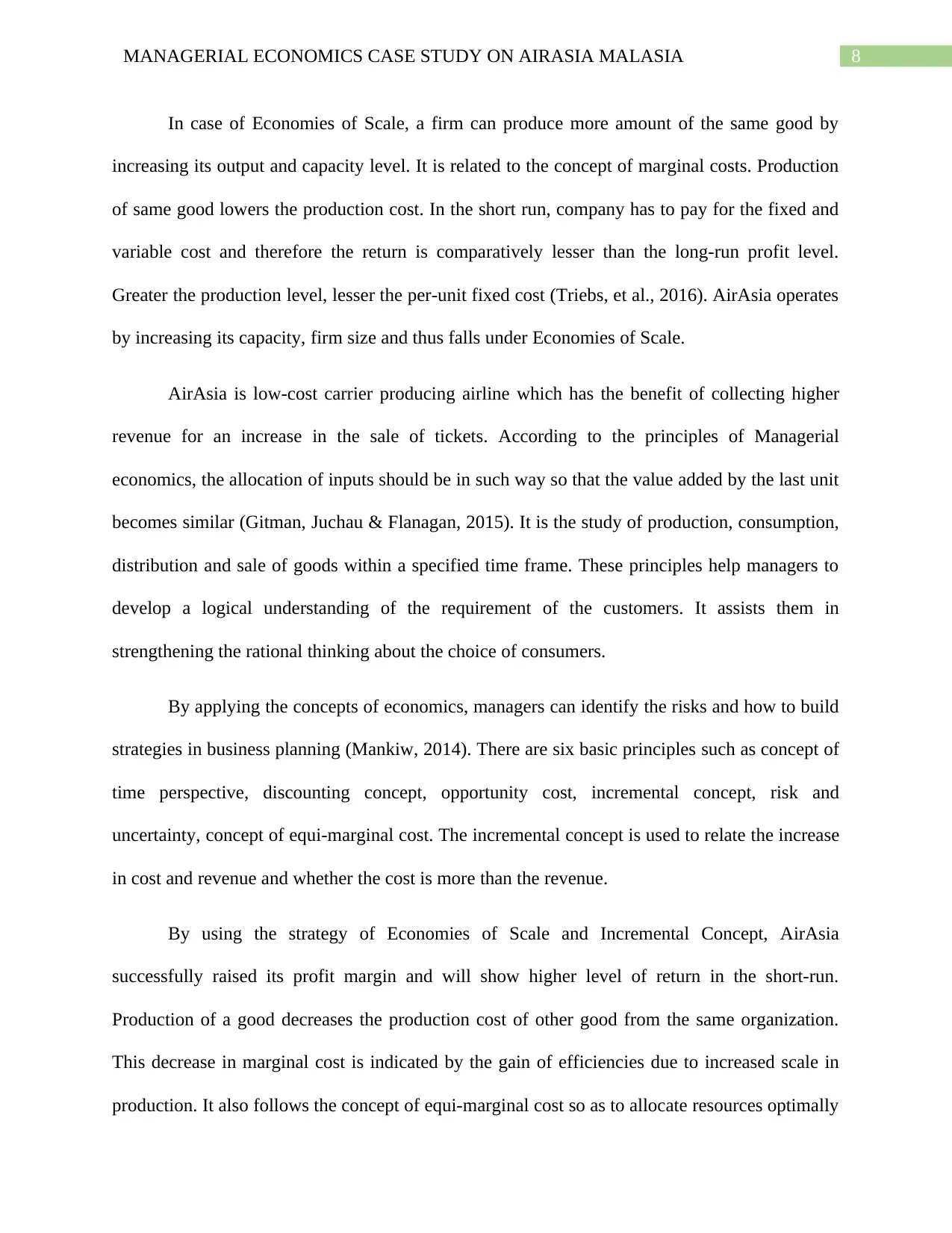
8MANAGERIAL ECONOMICS CASE STUDY ON AIRASIA MALASIA
In case of Economies of Scale, a firm can produce more amount of the same good by
increasing its output and capacity level. It is related to the concept of marginal costs. Production
of same good lowers the production cost. In the short run, company has to pay for the fixed and
variable cost and therefore the return is comparatively lesser than the long-run profit level.
Greater the production level, lesser the per-unit fixed cost (Triebs, et al., 2016). AirAsia operates
by increasing its capacity, firm size and thus falls under Economies of Scale.
AirAsia is low-cost carrier producing airline which has the benefit of collecting higher
revenue for an increase in the sale of tickets. According to the principles of Managerial
economics, the allocation of inputs should be in such way so that the value added by the last unit
becomes similar (Gitman, Juchau & Flanagan, 2015). It is the study of production, consumption,
distribution and sale of goods within a specified time frame. These principles help managers to
develop a logical understanding of the requirement of the customers. It assists them in
strengthening the rational thinking about the choice of consumers.
By applying the concepts of economics, managers can identify the risks and how to build
strategies in business planning (Mankiw, 2014). There are six basic principles such as concept of
time perspective, discounting concept, opportunity cost, incremental concept, risk and
uncertainty, concept of equi-marginal cost. The incremental concept is used to relate the increase
in cost and revenue and whether the cost is more than the revenue.
By using the strategy of Economies of Scale and Incremental Concept, AirAsia
successfully raised its profit margin and will show higher level of return in the short-run.
Production of a good decreases the production cost of other good from the same organization.
This decrease in marginal cost is indicated by the gain of efficiencies due to increased scale in
production. It also follows the concept of equi-marginal cost so as to allocate resources optimally
In case of Economies of Scale, a firm can produce more amount of the same good by
increasing its output and capacity level. It is related to the concept of marginal costs. Production
of same good lowers the production cost. In the short run, company has to pay for the fixed and
variable cost and therefore the return is comparatively lesser than the long-run profit level.
Greater the production level, lesser the per-unit fixed cost (Triebs, et al., 2016). AirAsia operates
by increasing its capacity, firm size and thus falls under Economies of Scale.
AirAsia is low-cost carrier producing airline which has the benefit of collecting higher
revenue for an increase in the sale of tickets. According to the principles of Managerial
economics, the allocation of inputs should be in such way so that the value added by the last unit
becomes similar (Gitman, Juchau & Flanagan, 2015). It is the study of production, consumption,
distribution and sale of goods within a specified time frame. These principles help managers to
develop a logical understanding of the requirement of the customers. It assists them in
strengthening the rational thinking about the choice of consumers.
By applying the concepts of economics, managers can identify the risks and how to build
strategies in business planning (Mankiw, 2014). There are six basic principles such as concept of
time perspective, discounting concept, opportunity cost, incremental concept, risk and
uncertainty, concept of equi-marginal cost. The incremental concept is used to relate the increase
in cost and revenue and whether the cost is more than the revenue.
By using the strategy of Economies of Scale and Incremental Concept, AirAsia
successfully raised its profit margin and will show higher level of return in the short-run.
Production of a good decreases the production cost of other good from the same organization.
This decrease in marginal cost is indicated by the gain of efficiencies due to increased scale in
production. It also follows the concept of equi-marginal cost so as to allocate resources optimally
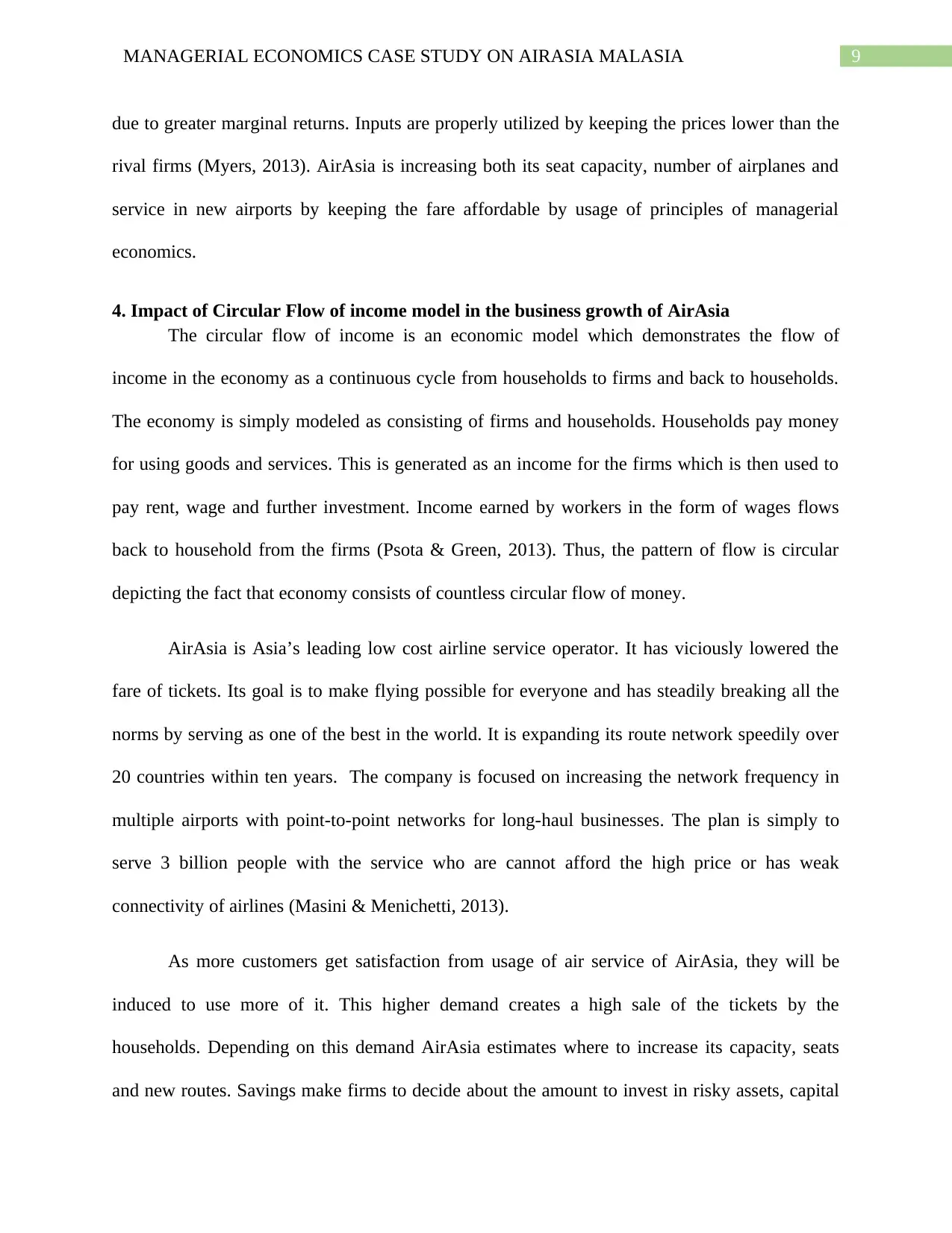
9MANAGERIAL ECONOMICS CASE STUDY ON AIRASIA MALASIA
due to greater marginal returns. Inputs are properly utilized by keeping the prices lower than the
rival firms (Myers, 2013). AirAsia is increasing both its seat capacity, number of airplanes and
service in new airports by keeping the fare affordable by usage of principles of managerial
economics.
4. Impact of Circular Flow of income model in the business growth of AirAsia
The circular flow of income is an economic model which demonstrates the flow of
income in the economy as a continuous cycle from households to firms and back to households.
The economy is simply modeled as consisting of firms and households. Households pay money
for using goods and services. This is generated as an income for the firms which is then used to
pay rent, wage and further investment. Income earned by workers in the form of wages flows
back to household from the firms (Psota & Green, 2013). Thus, the pattern of flow is circular
depicting the fact that economy consists of countless circular flow of money.
AirAsia is Asia’s leading low cost airline service operator. It has viciously lowered the
fare of tickets. Its goal is to make flying possible for everyone and has steadily breaking all the
norms by serving as one of the best in the world. It is expanding its route network speedily over
20 countries within ten years. The company is focused on increasing the network frequency in
multiple airports with point-to-point networks for long-haul businesses. The plan is simply to
serve 3 billion people with the service who are cannot afford the high price or has weak
connectivity of airlines (Masini & Menichetti, 2013).
As more customers get satisfaction from usage of air service of AirAsia, they will be
induced to use more of it. This higher demand creates a high sale of the tickets by the
households. Depending on this demand AirAsia estimates where to increase its capacity, seats
and new routes. Savings make firms to decide about the amount to invest in risky assets, capital
due to greater marginal returns. Inputs are properly utilized by keeping the prices lower than the
rival firms (Myers, 2013). AirAsia is increasing both its seat capacity, number of airplanes and
service in new airports by keeping the fare affordable by usage of principles of managerial
economics.
4. Impact of Circular Flow of income model in the business growth of AirAsia
The circular flow of income is an economic model which demonstrates the flow of
income in the economy as a continuous cycle from households to firms and back to households.
The economy is simply modeled as consisting of firms and households. Households pay money
for using goods and services. This is generated as an income for the firms which is then used to
pay rent, wage and further investment. Income earned by workers in the form of wages flows
back to household from the firms (Psota & Green, 2013). Thus, the pattern of flow is circular
depicting the fact that economy consists of countless circular flow of money.
AirAsia is Asia’s leading low cost airline service operator. It has viciously lowered the
fare of tickets. Its goal is to make flying possible for everyone and has steadily breaking all the
norms by serving as one of the best in the world. It is expanding its route network speedily over
20 countries within ten years. The company is focused on increasing the network frequency in
multiple airports with point-to-point networks for long-haul businesses. The plan is simply to
serve 3 billion people with the service who are cannot afford the high price or has weak
connectivity of airlines (Masini & Menichetti, 2013).
As more customers get satisfaction from usage of air service of AirAsia, they will be
induced to use more of it. This higher demand creates a high sale of the tickets by the
households. Depending on this demand AirAsia estimates where to increase its capacity, seats
and new routes. Savings make firms to decide about the amount to invest in risky assets, capital
Secure Best Marks with AI Grader
Need help grading? Try our AI Grader for instant feedback on your assignments.
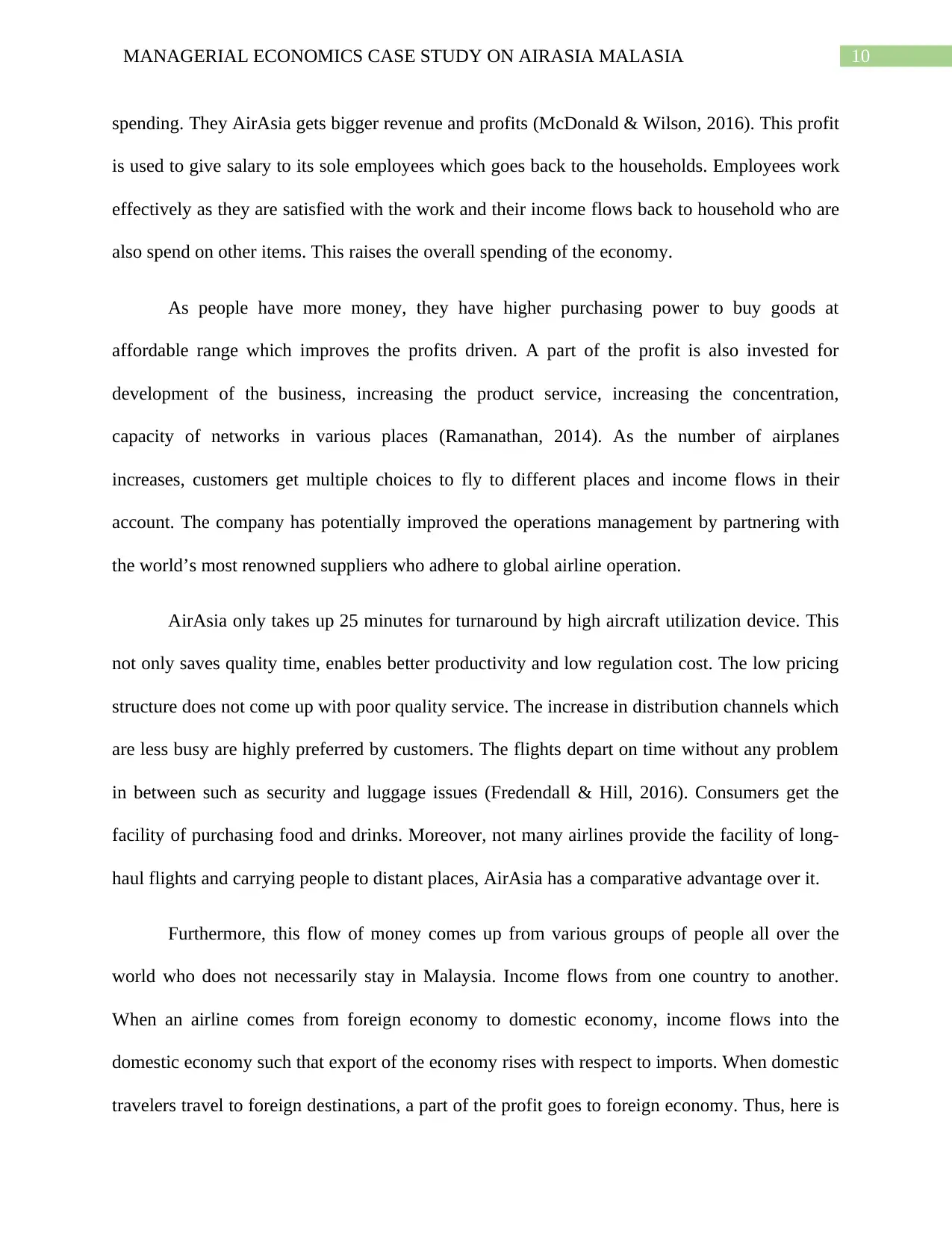
10MANAGERIAL ECONOMICS CASE STUDY ON AIRASIA MALASIA
spending. They AirAsia gets bigger revenue and profits (McDonald & Wilson, 2016). This profit
is used to give salary to its sole employees which goes back to the households. Employees work
effectively as they are satisfied with the work and their income flows back to household who are
also spend on other items. This raises the overall spending of the economy.
As people have more money, they have higher purchasing power to buy goods at
affordable range which improves the profits driven. A part of the profit is also invested for
development of the business, increasing the product service, increasing the concentration,
capacity of networks in various places (Ramanathan, 2014). As the number of airplanes
increases, customers get multiple choices to fly to different places and income flows in their
account. The company has potentially improved the operations management by partnering with
the world’s most renowned suppliers who adhere to global airline operation.
AirAsia only takes up 25 minutes for turnaround by high aircraft utilization device. This
not only saves quality time, enables better productivity and low regulation cost. The low pricing
structure does not come up with poor quality service. The increase in distribution channels which
are less busy are highly preferred by customers. The flights depart on time without any problem
in between such as security and luggage issues (Fredendall & Hill, 2016). Consumers get the
facility of purchasing food and drinks. Moreover, not many airlines provide the facility of long-
haul flights and carrying people to distant places, AirAsia has a comparative advantage over it.
Furthermore, this flow of money comes up from various groups of people all over the
world who does not necessarily stay in Malaysia. Income flows from one country to another.
When an airline comes from foreign economy to domestic economy, income flows into the
domestic economy such that export of the economy rises with respect to imports. When domestic
travelers travel to foreign destinations, a part of the profit goes to foreign economy. Thus, here is
spending. They AirAsia gets bigger revenue and profits (McDonald & Wilson, 2016). This profit
is used to give salary to its sole employees which goes back to the households. Employees work
effectively as they are satisfied with the work and their income flows back to household who are
also spend on other items. This raises the overall spending of the economy.
As people have more money, they have higher purchasing power to buy goods at
affordable range which improves the profits driven. A part of the profit is also invested for
development of the business, increasing the product service, increasing the concentration,
capacity of networks in various places (Ramanathan, 2014). As the number of airplanes
increases, customers get multiple choices to fly to different places and income flows in their
account. The company has potentially improved the operations management by partnering with
the world’s most renowned suppliers who adhere to global airline operation.
AirAsia only takes up 25 minutes for turnaround by high aircraft utilization device. This
not only saves quality time, enables better productivity and low regulation cost. The low pricing
structure does not come up with poor quality service. The increase in distribution channels which
are less busy are highly preferred by customers. The flights depart on time without any problem
in between such as security and luggage issues (Fredendall & Hill, 2016). Consumers get the
facility of purchasing food and drinks. Moreover, not many airlines provide the facility of long-
haul flights and carrying people to distant places, AirAsia has a comparative advantage over it.
Furthermore, this flow of money comes up from various groups of people all over the
world who does not necessarily stay in Malaysia. Income flows from one country to another.
When an airline comes from foreign economy to domestic economy, income flows into the
domestic economy such that export of the economy rises with respect to imports. When domestic
travelers travel to foreign destinations, a part of the profit goes to foreign economy. Thus, here is
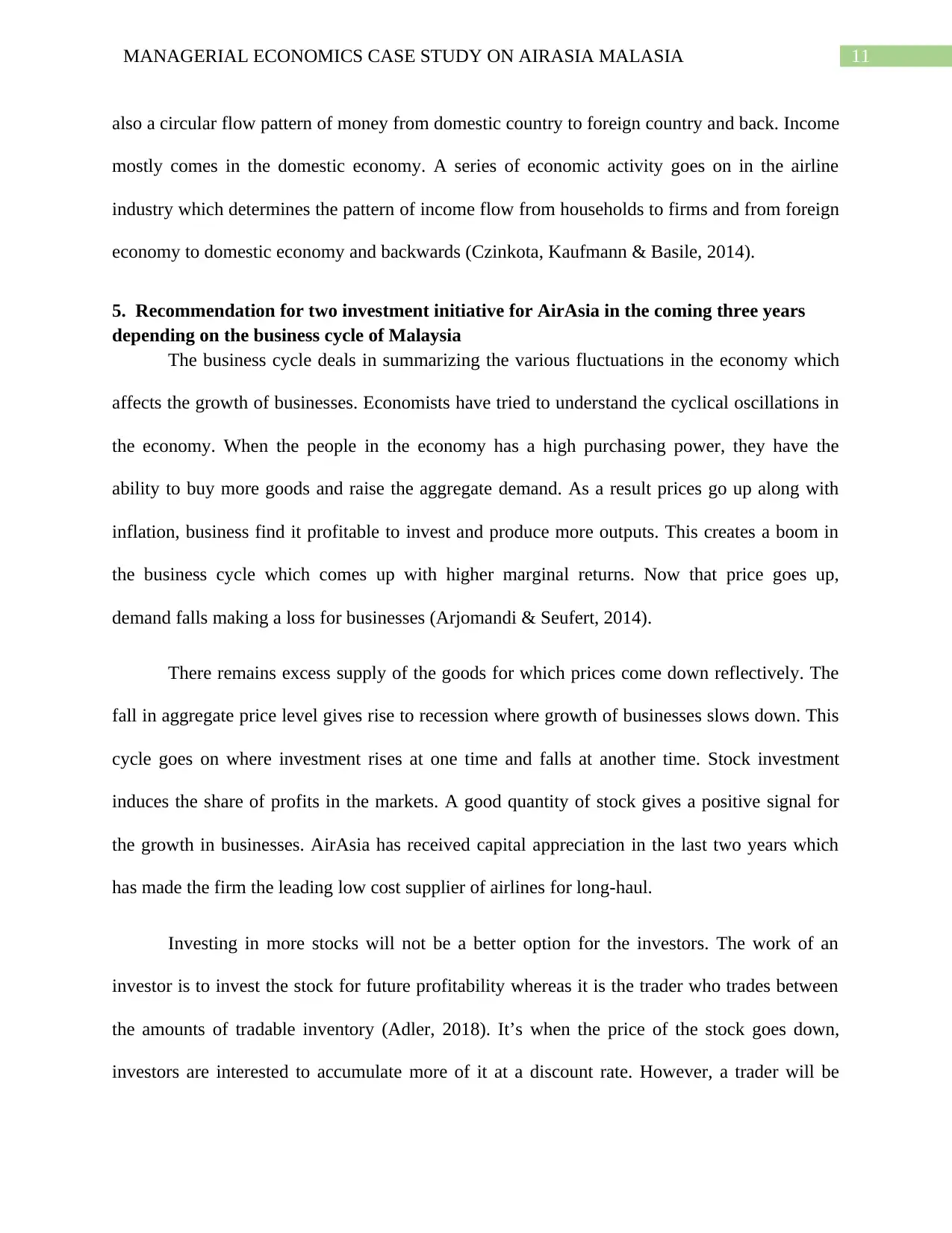
11MANAGERIAL ECONOMICS CASE STUDY ON AIRASIA MALASIA
also a circular flow pattern of money from domestic country to foreign country and back. Income
mostly comes in the domestic economy. A series of economic activity goes on in the airline
industry which determines the pattern of income flow from households to firms and from foreign
economy to domestic economy and backwards (Czinkota, Kaufmann & Basile, 2014).
5. Recommendation for two investment initiative for AirAsia in the coming three years
depending on the business cycle of Malaysia
The business cycle deals in summarizing the various fluctuations in the economy which
affects the growth of businesses. Economists have tried to understand the cyclical oscillations in
the economy. When the people in the economy has a high purchasing power, they have the
ability to buy more goods and raise the aggregate demand. As a result prices go up along with
inflation, business find it profitable to invest and produce more outputs. This creates a boom in
the business cycle which comes up with higher marginal returns. Now that price goes up,
demand falls making a loss for businesses (Arjomandi & Seufert, 2014).
There remains excess supply of the goods for which prices come down reflectively. The
fall in aggregate price level gives rise to recession where growth of businesses slows down. This
cycle goes on where investment rises at one time and falls at another time. Stock investment
induces the share of profits in the markets. A good quantity of stock gives a positive signal for
the growth in businesses. AirAsia has received capital appreciation in the last two years which
has made the firm the leading low cost supplier of airlines for long-haul.
Investing in more stocks will not be a better option for the investors. The work of an
investor is to invest the stock for future profitability whereas it is the trader who trades between
the amounts of tradable inventory (Adler, 2018). It’s when the price of the stock goes down,
investors are interested to accumulate more of it at a discount rate. However, a trader will be
also a circular flow pattern of money from domestic country to foreign country and back. Income
mostly comes in the domestic economy. A series of economic activity goes on in the airline
industry which determines the pattern of income flow from households to firms and from foreign
economy to domestic economy and backwards (Czinkota, Kaufmann & Basile, 2014).
5. Recommendation for two investment initiative for AirAsia in the coming three years
depending on the business cycle of Malaysia
The business cycle deals in summarizing the various fluctuations in the economy which
affects the growth of businesses. Economists have tried to understand the cyclical oscillations in
the economy. When the people in the economy has a high purchasing power, they have the
ability to buy more goods and raise the aggregate demand. As a result prices go up along with
inflation, business find it profitable to invest and produce more outputs. This creates a boom in
the business cycle which comes up with higher marginal returns. Now that price goes up,
demand falls making a loss for businesses (Arjomandi & Seufert, 2014).
There remains excess supply of the goods for which prices come down reflectively. The
fall in aggregate price level gives rise to recession where growth of businesses slows down. This
cycle goes on where investment rises at one time and falls at another time. Stock investment
induces the share of profits in the markets. A good quantity of stock gives a positive signal for
the growth in businesses. AirAsia has received capital appreciation in the last two years which
has made the firm the leading low cost supplier of airlines for long-haul.
Investing in more stocks will not be a better option for the investors. The work of an
investor is to invest the stock for future profitability whereas it is the trader who trades between
the amounts of tradable inventory (Adler, 2018). It’s when the price of the stock goes down,
investors are interested to accumulate more of it at a discount rate. However, a trader will be
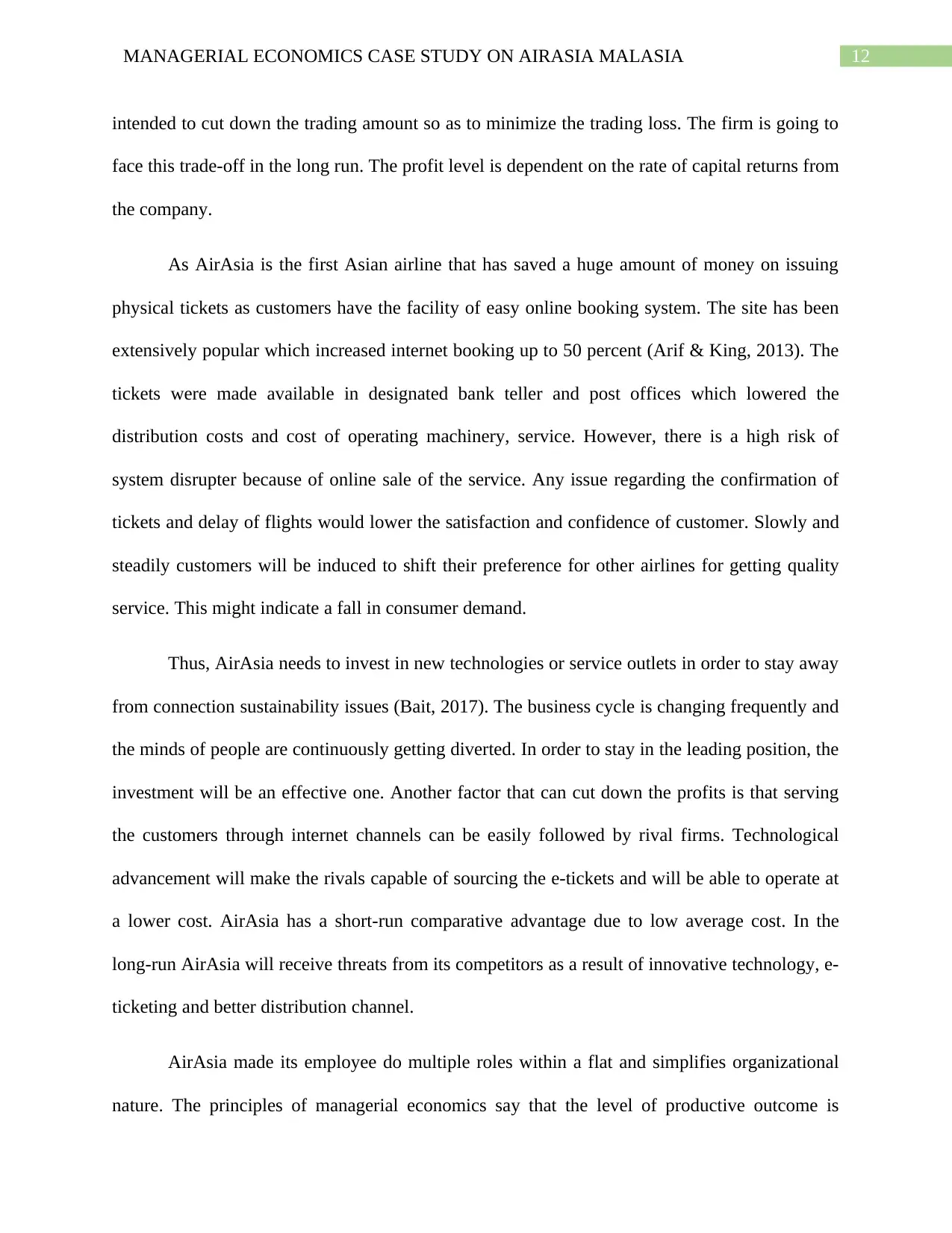
12MANAGERIAL ECONOMICS CASE STUDY ON AIRASIA MALASIA
intended to cut down the trading amount so as to minimize the trading loss. The firm is going to
face this trade-off in the long run. The profit level is dependent on the rate of capital returns from
the company.
As AirAsia is the first Asian airline that has saved a huge amount of money on issuing
physical tickets as customers have the facility of easy online booking system. The site has been
extensively popular which increased internet booking up to 50 percent (Arif & King, 2013). The
tickets were made available in designated bank teller and post offices which lowered the
distribution costs and cost of operating machinery, service. However, there is a high risk of
system disrupter because of online sale of the service. Any issue regarding the confirmation of
tickets and delay of flights would lower the satisfaction and confidence of customer. Slowly and
steadily customers will be induced to shift their preference for other airlines for getting quality
service. This might indicate a fall in consumer demand.
Thus, AirAsia needs to invest in new technologies or service outlets in order to stay away
from connection sustainability issues (Bait, 2017). The business cycle is changing frequently and
the minds of people are continuously getting diverted. In order to stay in the leading position, the
investment will be an effective one. Another factor that can cut down the profits is that serving
the customers through internet channels can be easily followed by rival firms. Technological
advancement will make the rivals capable of sourcing the e-tickets and will be able to operate at
a lower cost. AirAsia has a short-run comparative advantage due to low average cost. In the
long-run AirAsia will receive threats from its competitors as a result of innovative technology, e-
ticketing and better distribution channel.
AirAsia made its employee do multiple roles within a flat and simplifies organizational
nature. The principles of managerial economics say that the level of productive outcome is
intended to cut down the trading amount so as to minimize the trading loss. The firm is going to
face this trade-off in the long run. The profit level is dependent on the rate of capital returns from
the company.
As AirAsia is the first Asian airline that has saved a huge amount of money on issuing
physical tickets as customers have the facility of easy online booking system. The site has been
extensively popular which increased internet booking up to 50 percent (Arif & King, 2013). The
tickets were made available in designated bank teller and post offices which lowered the
distribution costs and cost of operating machinery, service. However, there is a high risk of
system disrupter because of online sale of the service. Any issue regarding the confirmation of
tickets and delay of flights would lower the satisfaction and confidence of customer. Slowly and
steadily customers will be induced to shift their preference for other airlines for getting quality
service. This might indicate a fall in consumer demand.
Thus, AirAsia needs to invest in new technologies or service outlets in order to stay away
from connection sustainability issues (Bait, 2017). The business cycle is changing frequently and
the minds of people are continuously getting diverted. In order to stay in the leading position, the
investment will be an effective one. Another factor that can cut down the profits is that serving
the customers through internet channels can be easily followed by rival firms. Technological
advancement will make the rivals capable of sourcing the e-tickets and will be able to operate at
a lower cost. AirAsia has a short-run comparative advantage due to low average cost. In the
long-run AirAsia will receive threats from its competitors as a result of innovative technology, e-
ticketing and better distribution channel.
AirAsia made its employee do multiple roles within a flat and simplifies organizational
nature. The principles of managerial economics say that the level of productive outcome is
Paraphrase This Document
Need a fresh take? Get an instant paraphrase of this document with our AI Paraphraser
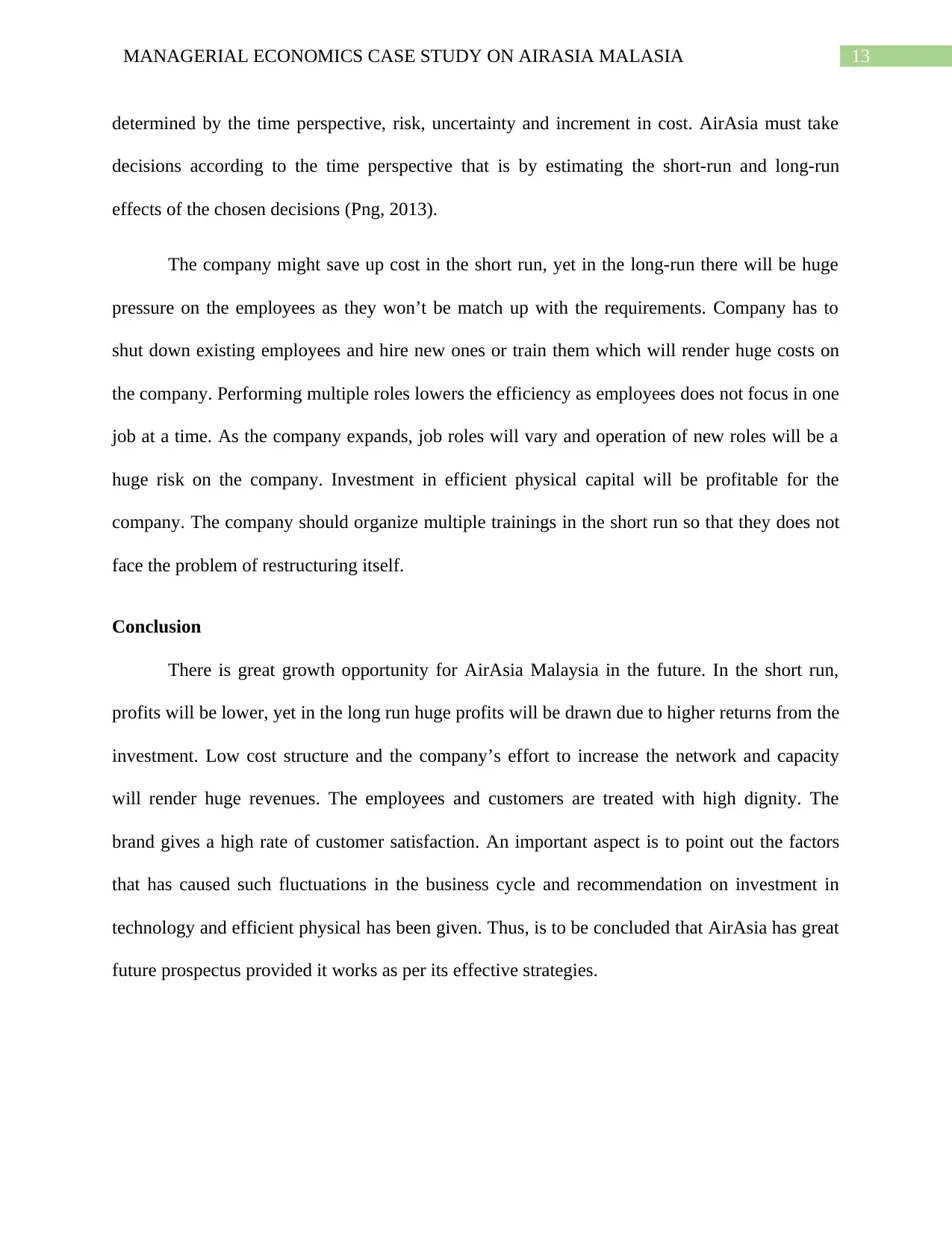
13MANAGERIAL ECONOMICS CASE STUDY ON AIRASIA MALASIA
determined by the time perspective, risk, uncertainty and increment in cost. AirAsia must take
decisions according to the time perspective that is by estimating the short-run and long-run
effects of the chosen decisions (Png, 2013).
The company might save up cost in the short run, yet in the long-run there will be huge
pressure on the employees as they won’t be match up with the requirements. Company has to
shut down existing employees and hire new ones or train them which will render huge costs on
the company. Performing multiple roles lowers the efficiency as employees does not focus in one
job at a time. As the company expands, job roles will vary and operation of new roles will be a
huge risk on the company. Investment in efficient physical capital will be profitable for the
company. The company should organize multiple trainings in the short run so that they does not
face the problem of restructuring itself.
Conclusion
There is great growth opportunity for AirAsia Malaysia in the future. In the short run,
profits will be lower, yet in the long run huge profits will be drawn due to higher returns from the
investment. Low cost structure and the company’s effort to increase the network and capacity
will render huge revenues. The employees and customers are treated with high dignity. The
brand gives a high rate of customer satisfaction. An important aspect is to point out the factors
that has caused such fluctuations in the business cycle and recommendation on investment in
technology and efficient physical has been given. Thus, is to be concluded that AirAsia has great
future prospectus provided it works as per its effective strategies.
determined by the time perspective, risk, uncertainty and increment in cost. AirAsia must take
decisions according to the time perspective that is by estimating the short-run and long-run
effects of the chosen decisions (Png, 2013).
The company might save up cost in the short run, yet in the long-run there will be huge
pressure on the employees as they won’t be match up with the requirements. Company has to
shut down existing employees and hire new ones or train them which will render huge costs on
the company. Performing multiple roles lowers the efficiency as employees does not focus in one
job at a time. As the company expands, job roles will vary and operation of new roles will be a
huge risk on the company. Investment in efficient physical capital will be profitable for the
company. The company should organize multiple trainings in the short run so that they does not
face the problem of restructuring itself.
Conclusion
There is great growth opportunity for AirAsia Malaysia in the future. In the short run,
profits will be lower, yet in the long run huge profits will be drawn due to higher returns from the
investment. Low cost structure and the company’s effort to increase the network and capacity
will render huge revenues. The employees and customers are treated with high dignity. The
brand gives a high rate of customer satisfaction. An important aspect is to point out the factors
that has caused such fluctuations in the business cycle and recommendation on investment in
technology and efficient physical has been given. Thus, is to be concluded that AirAsia has great
future prospectus provided it works as per its effective strategies.
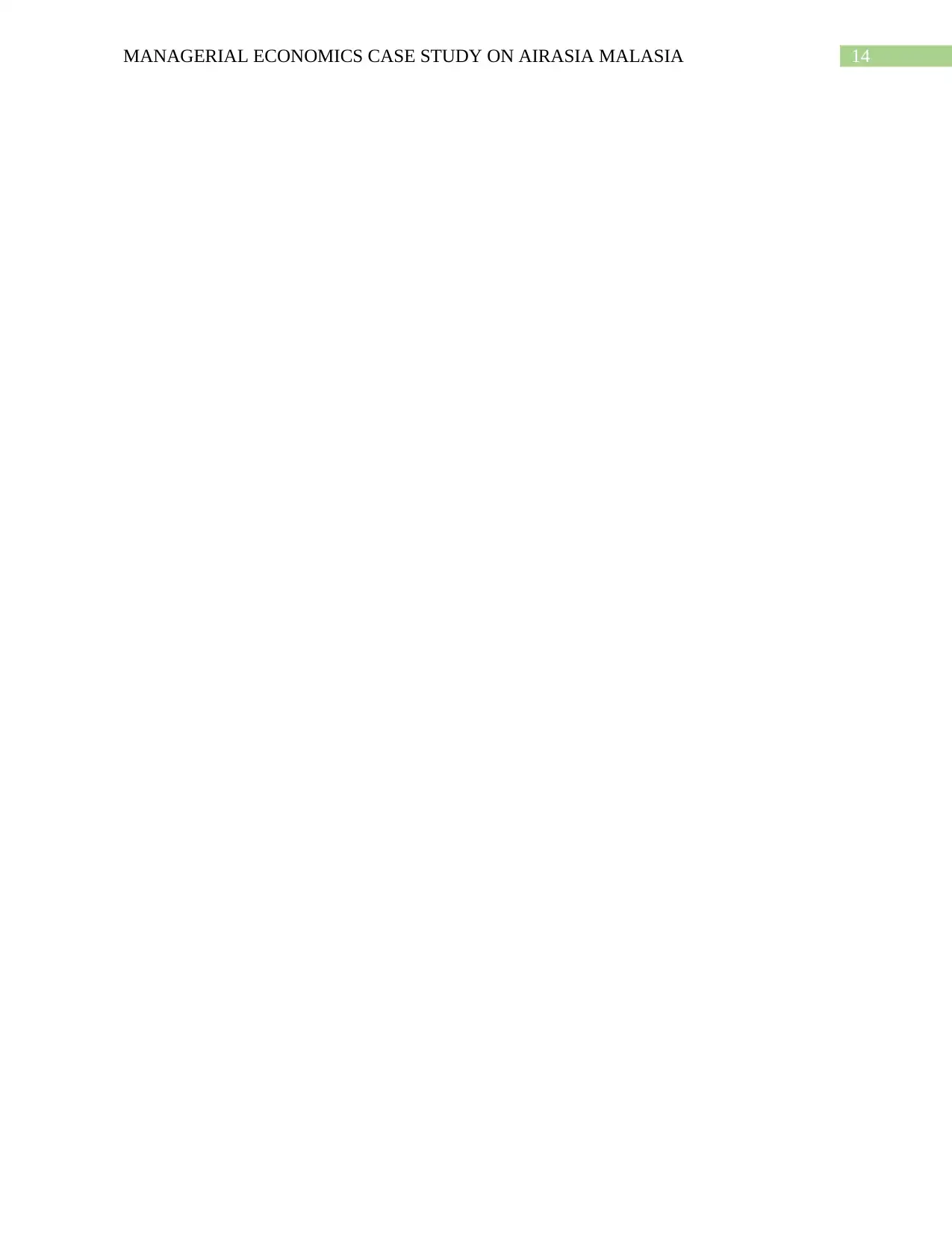
14MANAGERIAL ECONOMICS CASE STUDY ON AIRASIA MALASIA
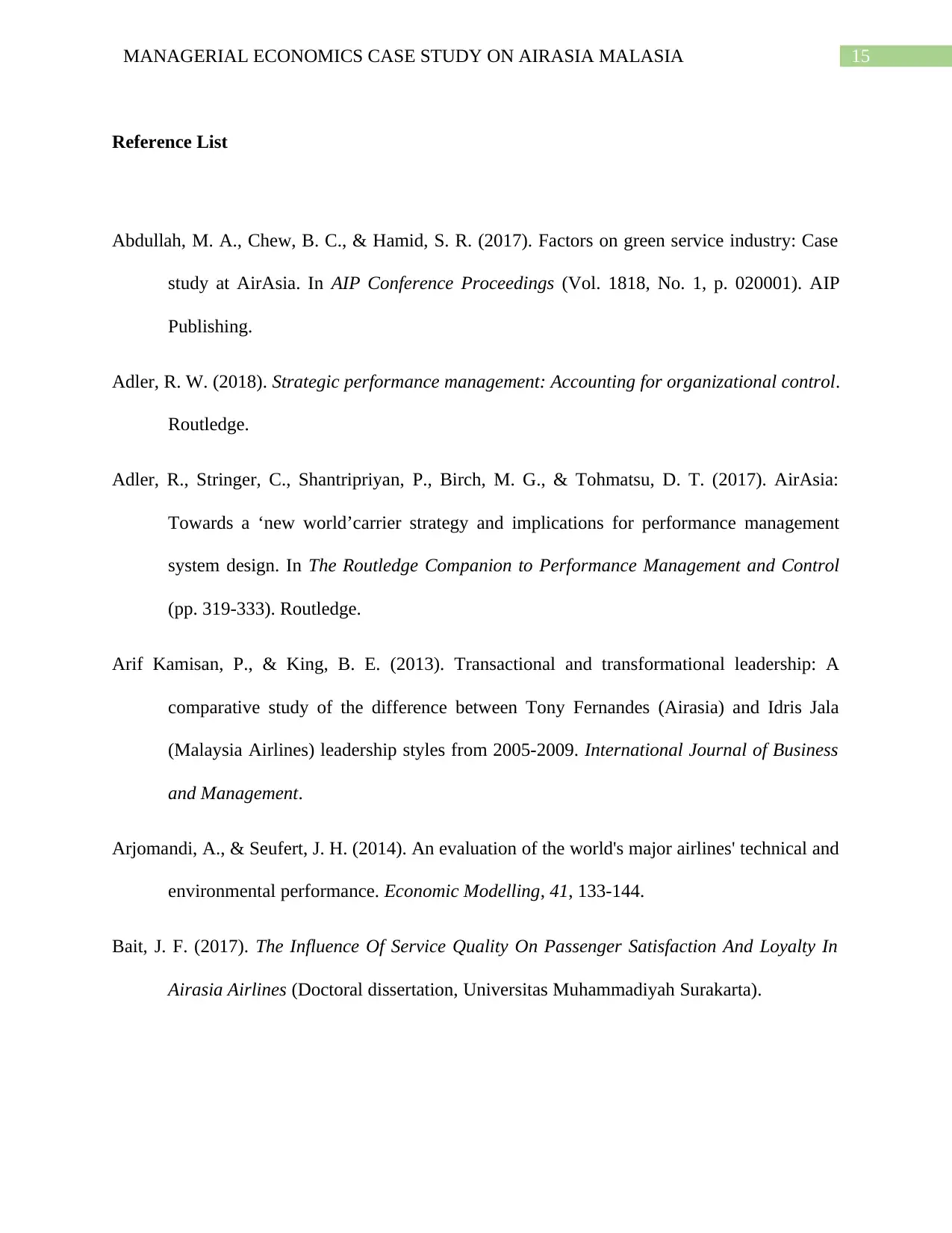
15MANAGERIAL ECONOMICS CASE STUDY ON AIRASIA MALASIA
Reference List
Abdullah, M. A., Chew, B. C., & Hamid, S. R. (2017). Factors on green service industry: Case
study at AirAsia. In AIP Conference Proceedings (Vol. 1818, No. 1, p. 020001). AIP
Publishing.
Adler, R. W. (2018). Strategic performance management: Accounting for organizational control.
Routledge.
Adler, R., Stringer, C., Shantripriyan, P., Birch, M. G., & Tohmatsu, D. T. (2017). AirAsia:
Towards a ‘new world’carrier strategy and implications for performance management
system design. In The Routledge Companion to Performance Management and Control
(pp. 319-333). Routledge.
Arif Kamisan, P., & King, B. E. (2013). Transactional and transformational leadership: A
comparative study of the difference between Tony Fernandes (Airasia) and Idris Jala
(Malaysia Airlines) leadership styles from 2005-2009. International Journal of Business
and Management.
Arjomandi, A., & Seufert, J. H. (2014). An evaluation of the world's major airlines' technical and
environmental performance. Economic Modelling, 41, 133-144.
Bait, J. F. (2017). The Influence Of Service Quality On Passenger Satisfaction And Loyalty In
Airasia Airlines (Doctoral dissertation, Universitas Muhammadiyah Surakarta).
Reference List
Abdullah, M. A., Chew, B. C., & Hamid, S. R. (2017). Factors on green service industry: Case
study at AirAsia. In AIP Conference Proceedings (Vol. 1818, No. 1, p. 020001). AIP
Publishing.
Adler, R. W. (2018). Strategic performance management: Accounting for organizational control.
Routledge.
Adler, R., Stringer, C., Shantripriyan, P., Birch, M. G., & Tohmatsu, D. T. (2017). AirAsia:
Towards a ‘new world’carrier strategy and implications for performance management
system design. In The Routledge Companion to Performance Management and Control
(pp. 319-333). Routledge.
Arif Kamisan, P., & King, B. E. (2013). Transactional and transformational leadership: A
comparative study of the difference between Tony Fernandes (Airasia) and Idris Jala
(Malaysia Airlines) leadership styles from 2005-2009. International Journal of Business
and Management.
Arjomandi, A., & Seufert, J. H. (2014). An evaluation of the world's major airlines' technical and
environmental performance. Economic Modelling, 41, 133-144.
Bait, J. F. (2017). The Influence Of Service Quality On Passenger Satisfaction And Loyalty In
Airasia Airlines (Doctoral dissertation, Universitas Muhammadiyah Surakarta).
Secure Best Marks with AI Grader
Need help grading? Try our AI Grader for instant feedback on your assignments.
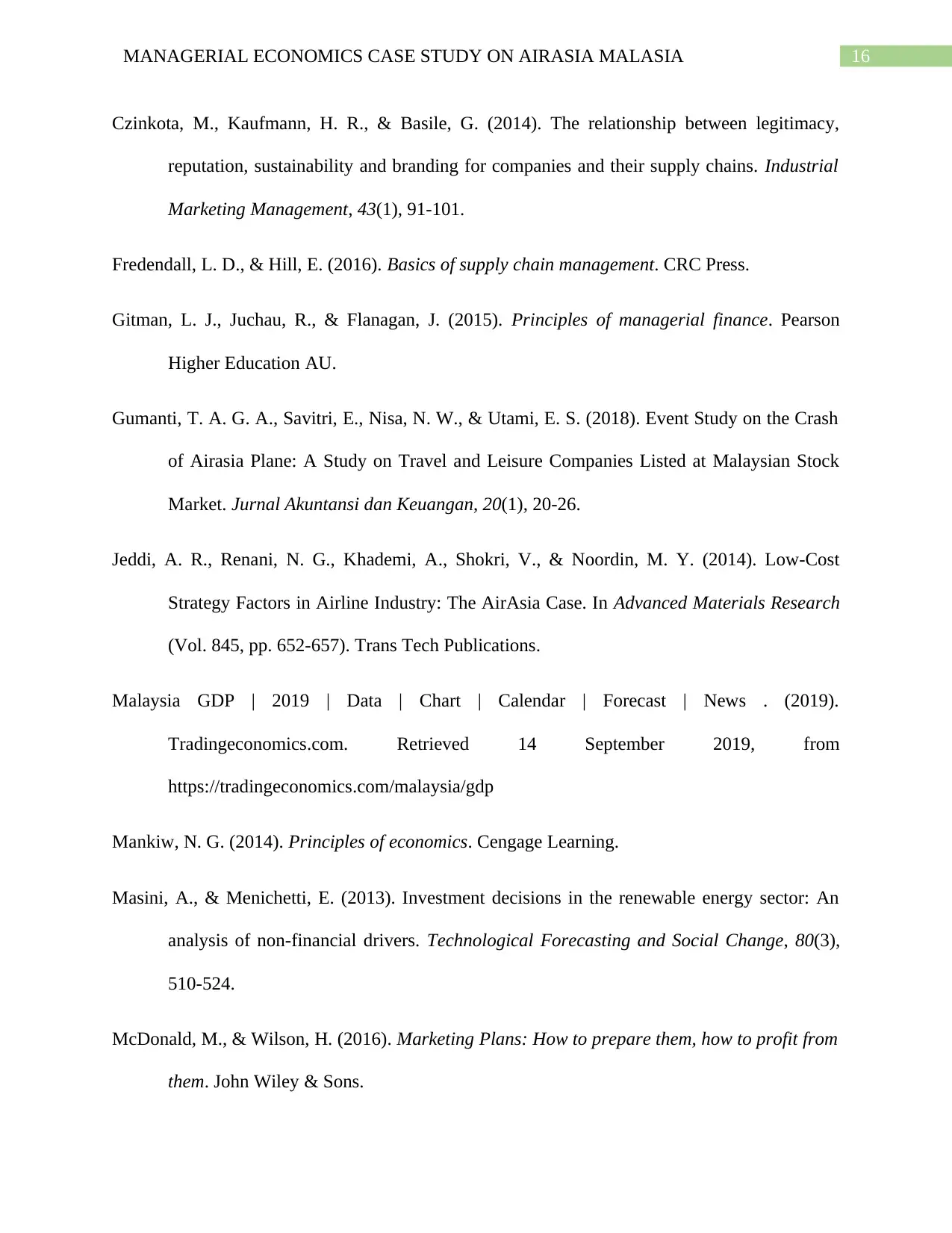
16MANAGERIAL ECONOMICS CASE STUDY ON AIRASIA MALASIA
Czinkota, M., Kaufmann, H. R., & Basile, G. (2014). The relationship between legitimacy,
reputation, sustainability and branding for companies and their supply chains. Industrial
Marketing Management, 43(1), 91-101.
Fredendall, L. D., & Hill, E. (2016). Basics of supply chain management. CRC Press.
Gitman, L. J., Juchau, R., & Flanagan, J. (2015). Principles of managerial finance. Pearson
Higher Education AU.
Gumanti, T. A. G. A., Savitri, E., Nisa, N. W., & Utami, E. S. (2018). Event Study on the Crash
of Airasia Plane: A Study on Travel and Leisure Companies Listed at Malaysian Stock
Market. Jurnal Akuntansi dan Keuangan, 20(1), 20-26.
Jeddi, A. R., Renani, N. G., Khademi, A., Shokri, V., & Noordin, M. Y. (2014). Low-Cost
Strategy Factors in Airline Industry: The AirAsia Case. In Advanced Materials Research
(Vol. 845, pp. 652-657). Trans Tech Publications.
Malaysia GDP | 2019 | Data | Chart | Calendar | Forecast | News . (2019).
Tradingeconomics.com. Retrieved 14 September 2019, from
https://tradingeconomics.com/malaysia/gdp
Mankiw, N. G. (2014). Principles of economics. Cengage Learning.
Masini, A., & Menichetti, E. (2013). Investment decisions in the renewable energy sector: An
analysis of non-financial drivers. Technological Forecasting and Social Change, 80(3),
510-524.
McDonald, M., & Wilson, H. (2016). Marketing Plans: How to prepare them, how to profit from
them. John Wiley & Sons.
Czinkota, M., Kaufmann, H. R., & Basile, G. (2014). The relationship between legitimacy,
reputation, sustainability and branding for companies and their supply chains. Industrial
Marketing Management, 43(1), 91-101.
Fredendall, L. D., & Hill, E. (2016). Basics of supply chain management. CRC Press.
Gitman, L. J., Juchau, R., & Flanagan, J. (2015). Principles of managerial finance. Pearson
Higher Education AU.
Gumanti, T. A. G. A., Savitri, E., Nisa, N. W., & Utami, E. S. (2018). Event Study on the Crash
of Airasia Plane: A Study on Travel and Leisure Companies Listed at Malaysian Stock
Market. Jurnal Akuntansi dan Keuangan, 20(1), 20-26.
Jeddi, A. R., Renani, N. G., Khademi, A., Shokri, V., & Noordin, M. Y. (2014). Low-Cost
Strategy Factors in Airline Industry: The AirAsia Case. In Advanced Materials Research
(Vol. 845, pp. 652-657). Trans Tech Publications.
Malaysia GDP | 2019 | Data | Chart | Calendar | Forecast | News . (2019).
Tradingeconomics.com. Retrieved 14 September 2019, from
https://tradingeconomics.com/malaysia/gdp
Mankiw, N. G. (2014). Principles of economics. Cengage Learning.
Masini, A., & Menichetti, E. (2013). Investment decisions in the renewable energy sector: An
analysis of non-financial drivers. Technological Forecasting and Social Change, 80(3),
510-524.
McDonald, M., & Wilson, H. (2016). Marketing Plans: How to prepare them, how to profit from
them. John Wiley & Sons.
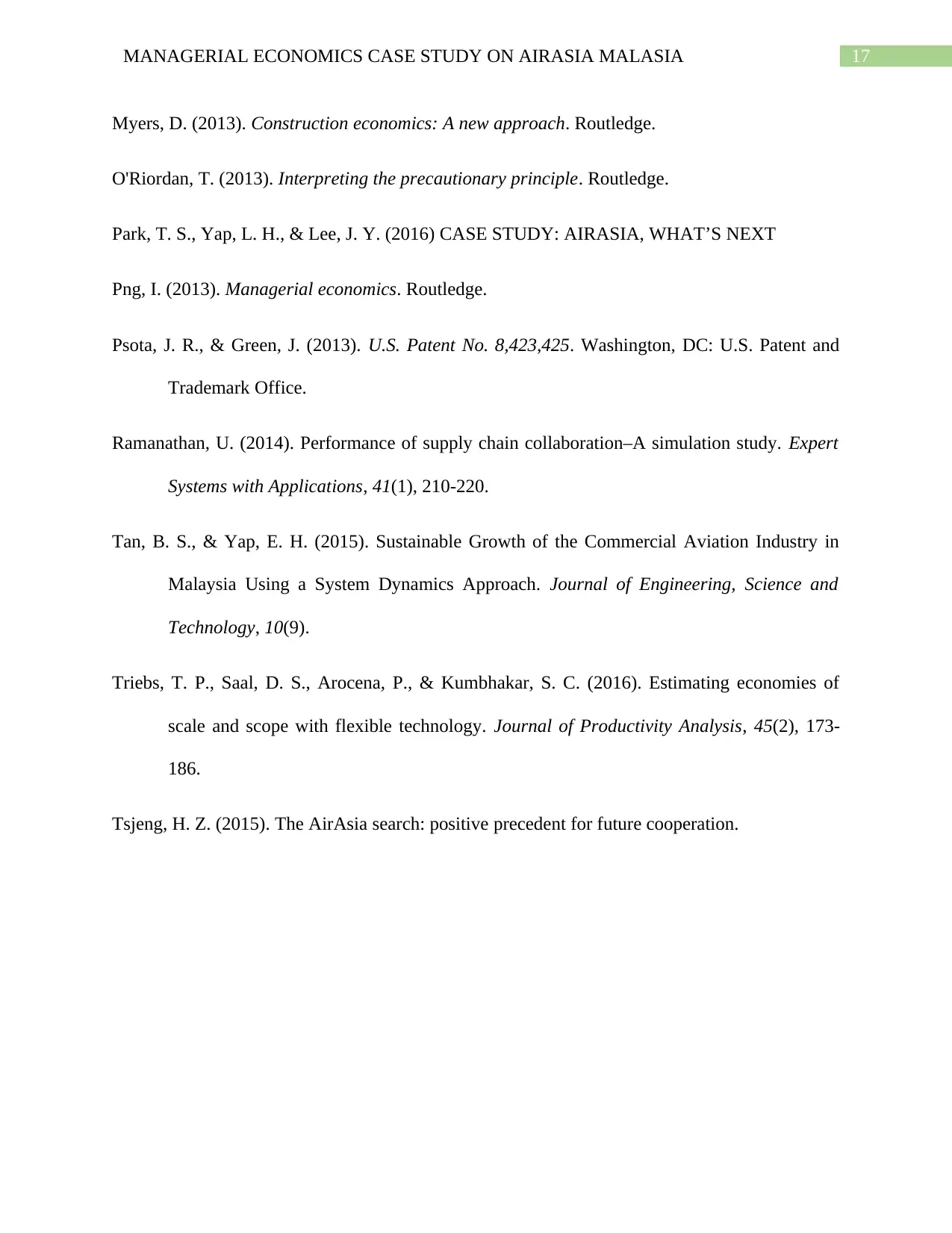
17MANAGERIAL ECONOMICS CASE STUDY ON AIRASIA MALASIA
Myers, D. (2013). Construction economics: A new approach. Routledge.
O'Riordan, T. (2013). Interpreting the precautionary principle. Routledge.
Park, T. S., Yap, L. H., & Lee, J. Y. (2016) CASE STUDY: AIRASIA, WHAT’S NEXT
Png, I. (2013). Managerial economics. Routledge.
Psota, J. R., & Green, J. (2013). U.S. Patent No. 8,423,425. Washington, DC: U.S. Patent and
Trademark Office.
Ramanathan, U. (2014). Performance of supply chain collaboration–A simulation study. Expert
Systems with Applications, 41(1), 210-220.
Tan, B. S., & Yap, E. H. (2015). Sustainable Growth of the Commercial Aviation Industry in
Malaysia Using a System Dynamics Approach. Journal of Engineering, Science and
Technology, 10(9).
Triebs, T. P., Saal, D. S., Arocena, P., & Kumbhakar, S. C. (2016). Estimating economies of
scale and scope with flexible technology. Journal of Productivity Analysis, 45(2), 173-
186.
Tsjeng, H. Z. (2015). The AirAsia search: positive precedent for future cooperation.
Myers, D. (2013). Construction economics: A new approach. Routledge.
O'Riordan, T. (2013). Interpreting the precautionary principle. Routledge.
Park, T. S., Yap, L. H., & Lee, J. Y. (2016) CASE STUDY: AIRASIA, WHAT’S NEXT
Png, I. (2013). Managerial economics. Routledge.
Psota, J. R., & Green, J. (2013). U.S. Patent No. 8,423,425. Washington, DC: U.S. Patent and
Trademark Office.
Ramanathan, U. (2014). Performance of supply chain collaboration–A simulation study. Expert
Systems with Applications, 41(1), 210-220.
Tan, B. S., & Yap, E. H. (2015). Sustainable Growth of the Commercial Aviation Industry in
Malaysia Using a System Dynamics Approach. Journal of Engineering, Science and
Technology, 10(9).
Triebs, T. P., Saal, D. S., Arocena, P., & Kumbhakar, S. C. (2016). Estimating economies of
scale and scope with flexible technology. Journal of Productivity Analysis, 45(2), 173-
186.
Tsjeng, H. Z. (2015). The AirAsia search: positive precedent for future cooperation.
1 out of 18
Related Documents
Your All-in-One AI-Powered Toolkit for Academic Success.
+13062052269
info@desklib.com
Available 24*7 on WhatsApp / Email
![[object Object]](/_next/static/media/star-bottom.7253800d.svg)
Unlock your academic potential
© 2024 | Zucol Services PVT LTD | All rights reserved.





